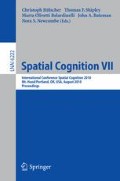Abstract
Physical analog models are a common pedagogical device in Earth and Environmental Science education for helping students bridge the vast scale difference between the Earth and the classroom. Gentner’s structural framework for analogical reasoning has been used to map the correspondences and non-correspondences between two widely-used analog models and the relevant portions of the Earth System. A classroom model of convection in an aquarium has important correspondences to the atmospheric Hadley cell at the levels of attributes, simple relations, higher order relations and systematicity. A volcano eruption model lacks the relations among lava flow temperature, viscosity, and distance that result in construction of the distinctive conical shape of real volcanoes. Analogical mappings of classroom models can be used to guide the design of instruction and assessment so as to increase the chances that students will understand the Earth system at the level of higher-order relations rather than superficial attributes.
Access this chapter
Tax calculation will be finalised at checkout
Purchases are for personal use only
Preview
Unable to display preview. Download preview PDF.
References
Van Cleave, J.: Earth Science for Every Kid. John Wiley & Sons, New York (1991)
NASA’s Kids Science News NetworkTM: What causes night and day?, http://ksnn.larc.nasa.gov/night_and_day.html
Bryant Watershed Education Project: A Stream Table Makes a Miniature Stream, http://www.watersheds.org/earth/streamtable.htm
Lahr, J.C.: Table-top Earthquakes, http://jclahr.com/science/earth_science/tabletop/index.html
Bonnet, R.L., Keen, G.D.: Earth Science: 49 Science Fair Projects. McGraw-Hill, Inc. (TAB Books Division), New York (1990)
Feather Jr., R.M., Snyder, S.L., Hesser, D.T.: Merrill Earth Science. Macmillan/McGraw-Hill (Glencoe Division), Westerville (1993)
Gentner, D.: Structure-mapping: A theoretical framework for analogy. Cog. Sci. 7, 155–170 (1983)
Gentner, D., Gentner, D.R.: Flowing waters or teeming crowds: mental models of electricity. In: Gentner, D., Stevens, A.L. (eds.) Mental Models, pp. 99–129. Lawrence Erlbaum, Hillsdale (1983)
Gentner, D., Toupin, C.: Systemicity and surface similarity in the development of analogy. Cog. Sci. 10, 277–300 (1986)
Gentner, D., Colhoun, J.: Analogical processes in human thinking and learning. In: von Müller, A., Pöppel, E. (Series eds.), Glatzeder, B., Goel, V., von Müller, A. (vol. eds.) On Thinking: Towards a Theory of Thinking, vol. 2, pp. 1148–1158. Springer, Heidelberg (2010)
Freeman, C.: Convection in a Fish Tank. The Science Teacher 75, 62–66 (2008)
Skinner, B.J., Porter, S.C., Botkin, D.B.: The Blue Planet. John Wiley & Sons, Inc., New York (1999)
Helmenstine, A.: How to build a baking soda volcano, http://chemistry.about.com/cs/howtos/ht/buildavolcano.htm
USGS Volcano Hazards Program, http://volcanoes.usgs.gov/images/pglossary/effusive.php
Jee, B.D., Uttal, D.H., Gentner, D., Manduca, C., Shipley, T.F., Tikoff, B., Ormand, C.J., Sageman, B.: Commentary: Analogical Thinking in Geoscience Education. Journal of Geoscience Education 58(1), 2–13 (2010)
Sibley, D.: A cognitive framework for reasoning with scientific models. Journal of Geoscience Education 57(4), 255–263 (2009)
Illinois State Museum Geology Online, http://geologyonline.museum.state.il.us/tools/lessons/12.1/index.html
Richland, L.E., Zur, O., Holyoak, K.J.: Cognitive supports for analogies in the mathematics classroom. Science 316, 1128–1129 (2007)
Kurtz, K.J., Miao, C.-H., Gentner, D.: Learning by analogical bootstrapping. Journal of the Learning Sciences 10(4), 417–446 (2001)
Author information
Authors and Affiliations
Editor information
Editors and Affiliations
Rights and permissions
Copyright information
© 2010 Springer-Verlag Berlin Heidelberg
About this paper
Cite this paper
Kastens, K.A., Rivet, A. (2010). Using Analogical Mapping to Assess the Affordances of Scale Models Used in Earth and Environmental Science Education. In: Hölscher, C., Shipley, T.F., Olivetti Belardinelli, M., Bateman, J.A., Newcombe, N.S. (eds) Spatial Cognition VII. Spatial Cognition 2010. Lecture Notes in Computer Science(), vol 6222. Springer, Berlin, Heidelberg. https://doi.org/10.1007/978-3-642-14749-4_12
Download citation
DOI: https://doi.org/10.1007/978-3-642-14749-4_12
Publisher Name: Springer, Berlin, Heidelberg
Print ISBN: 978-3-642-14748-7
Online ISBN: 978-3-642-14749-4
eBook Packages: Computer ScienceComputer Science (R0)

